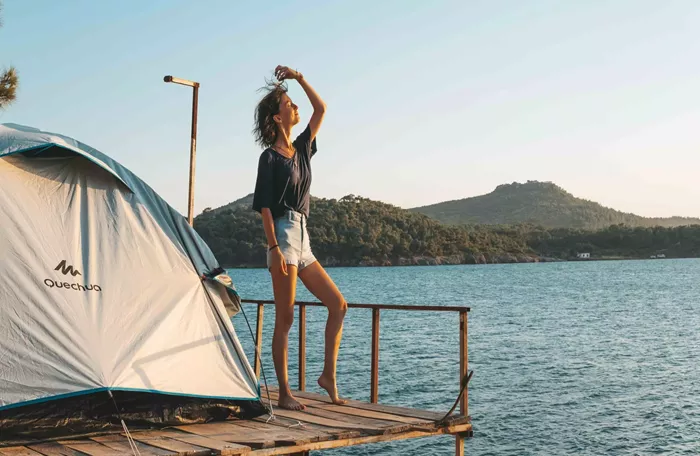Camping is a great way to connect with nature. But wearing the wrong clothes can ruin your trip. The right clothing keeps you comfortable, dry, and safe. This guide will help you choose the best camping clothes for any weather and activity.
Why Clothing Matters When Camping
Clothing is your first line of defense outdoors. It protects you from:
- Weather (rain, wind, sun, cold)
- Insects (mosquitoes, ticks)
- Injuries (scratches, sunburn)
Good camping clothes should be:
- Comfortable (easy to move in)
- Durable (lasts through rough use)
- Moisture-wicking (keeps you dry)
- Layered (adjusts to temperature changes)
Base Layer: The Foundation of Camping Clothing
Your base layer sits next to your skin. It helps regulate body temperature.
Materials for Base Layers
- Merino wool – Best for warmth and odor control.
- Synthetic (polyester, nylon) – Dries fast, good for sweating.
- Cotton – Avoid (absorbs sweat, stays wet).
When to Wear Different Base Layers
- Hot weather – Lightweight, breathable fabric.
- Cold weather – Thicker merino wool or thermal synthetics.
Mid Layer: Insulation for Warmth
The mid layer traps heat to keep you warm.
Best Mid Layer Options
- Fleece jacket – Light, warm, and breathable.
- Down jacket – Very warm but loses heat when wet.
- Synthetic insulated jacket – Works even when damp.
Choosing the Right Mid Layer
- Active camping (hiking, climbing) – Light fleece.
- Cold nights by the fire – Puffy down or synthetic jacket.
Outer Layer: Protection from Wind and Rain
Your outer layer shields you from rain, wind, and snow.
Types of Outer Layers
- Rain jacket – Waterproof and breathable (look for Gore-Tex).
- Windbreaker – Light protection for dry, windy days.
- Softshell jacket – Stretchy, resists light rain.
Features to Look For
- Taped seams – Prevents water leaks.
- Adjustable hood – Keeps rain off your face.
- Pockets – For easy access to essentials.
Bottoms: Pants and Shorts for Camping
Your legs need protection too. The right pants or shorts depend on the weather.
Best Camping Pants
- Convertible pants – Zip-off legs turn into shorts.
- Softshell pants – Stretchy, water-resistant.
- Hiking pants – Lightweight, quick-drying.
When to Wear Shorts
- Hot weather – Breathable, quick-dry fabric.
- Buggy areas – Wear long pants to avoid bites.
Footwear: Choosing the Right Shoes for Camping
Bad shoes can make camping miserable. Pick footwear based on terrain and weather.
Types of Camping Footwear
- Hiking boots – Best for rough trails, ankle support.
- Trail runners – Lightweight, good for dry conditions.
- Camp shoes (sandals, sneakers) – Comfortable for relaxing.
Socks Matter Too
- Merino wool socks – Warm, moisture-wicking.
- Synthetic blend socks – Durable, quick-drying.
Headwear and Accessories
Don’t forget these essentials for extra protection.
Must-Have Headwear
- Sun hat – Wide brim for sun protection.
- Beanie – Keeps you warm at night.
- Buff/neck gaiter – Protects from sun, wind, and dust.
Other Important Accessories
- Gloves – For cold weather or handling rough gear.
- Sunglasses – UV protection for eyes.
- Bandana – Multi-use (sweatband, emergency cloth).
Layering System: How to Adjust for Weather
Layering lets you adapt to changing temperatures.
The 3-Layer Rule
- Base layer – Manages sweat.
- Mid layer – Insulates.
- Outer layer – Blocks wind/rain.
Adding or Removing Layers
- Morning/night – Add layers (colder).
- Midday/hiking – Remove layers (warmer).
Seasonal Camping Clothing Guide
What you wear changes with the seasons.
Summer Camping Clothes
- Lightweight, breathable fabrics.
- Sun protection (hat, sunglasses).
- Quick-dry shorts and shirts.
Winter Camping Clothes
- Thermal base layers.
- Insulated jacket and pants.
- Waterproof gloves and boots.
Spring/Fall Camping Clothes
- Versatile layers (easy to add/remove).
- Water-resistant outer shell.
- Warm socks and gloves for chilly nights.
Special Considerations
Camping in Rainy Weather
- Full waterproof jacket and pants.
- Extra socks (feet get wet easily).
- Pack clothes in dry bags.
Camping in Buggy Areas
- Long sleeves and pants.
- Insect-repellent clothing.
- Head net for extreme cases.
Camping in High Altitude
- Warm layers (nights get very cold).
- Windproof outer shell.
- Sun protection (UV is stronger).
What NOT to Wear Camping
Some clothes are bad for camping. Avoid:
- Cotton jeans – Heavy, slow to dry.
- Flip-flops – No support, bad for trails.
- Perfumed fabrics – Attracts bugs.
Final Tips for Choosing Camping Clothes
- Test clothes before the trip – Make sure they fit well.
- Pack extra layers – Weather can change fast.
- Choose neutral colors – Bright colors attract bugs.
Conclusion
The right camping clothes make your trip more enjoyable. Focus on layers, moisture control, and protection. Always check the weather before packing. With the right outfit, you’ll stay comfortable in any condition. Happy camping!
Related topics:

